Related Research Articles

The Battle of Bosworth or Bosworth Field was the last significant battle of the Wars of the Roses, the civil war between the houses of Lancaster and York that extended across England in the latter half of the 15th century. Fought on 22 August 1485, the battle was won by an alliance of Lancastrians and disaffected Yorkists. Their leader Henry Tudor, Earl of Richmond, became the first English monarch of the Tudor dynasty by his victory and subsequent marriage to a Yorkist princess. His opponent Richard III, the last king of the House of York, was killed during the battle, the last English monarch to die in combat. Historians consider Bosworth Field to mark the end of the Plantagenet dynasty, making it one of the defining moments of English history.

Richard III was King of England from 26 June 1483 until his death in 1485. He was the last king of the Plantagenet dynasty and its cadet branch the House of York. His defeat and death at the Battle of Bosworth Field, the last decisive battle of the Wars of the Roses, marked the end of the Middle Ages in England.

The Battle of Stoke Field on 16 June 1487 may be considered the last battle of the Wars of the Roses, since it was the last major engagement between contenders for the throne whose claims derived from descent from the houses of Lancaster and York respectively. The Battle of Bosworth Field, two years previously, had established King Henry VII on the throne, ending the last period of Yorkist rule and initiating that of the Tudors. The Battle of Stoke Field was the decisive engagement in an attempt by leading Yorkists to unseat him in favour of the pretender Lambert Simnel.
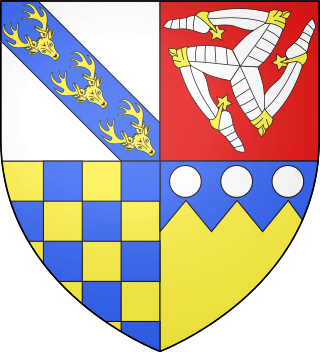
Thomas Stanley, 1st Earl of Derby, KG was an English nobleman. He was the stepfather of King Henry VII of England. He was the eldest son of Thomas Stanley, 1st Baron Stanley and Joan Goushill.

John Howard, 1st Duke of Norfolk, also known as Jack of Norfolk,, was an English nobleman, soldier, politician, and the first Howard Duke of Norfolk. He was a close friend and loyal supporter of King Richard III, with whom he was slain at the Battle of Bosworth in 1485.

Richard III is a play by William Shakespeare. It was probably written c. 1592–1594. It is labelled a history in the First Folio, and is usually considered one, but it is sometimes called a tragedy, as in the quarto edition. Richard III concludes Shakespeare's first tetralogy and depicts the Machiavellian rise to power and subsequent short reign of King Richard III of England.

The Battle of Flodden, Flodden Field, or occasionally Branxton or Brainston Moor was a battle that was fought on 9 September 1513 during the War of the League of Cambrai between the Kingdom of England and the Kingdom of Scotland and resulted in an English victory. The battle was fought near Branxton, in the county of Northumberland, in northern England, between an invading Scots army under King James IV and an English army commanded by the Earl of Surrey. In terms of troop numbers, it was the largest battle ever fought between the two kingdoms.
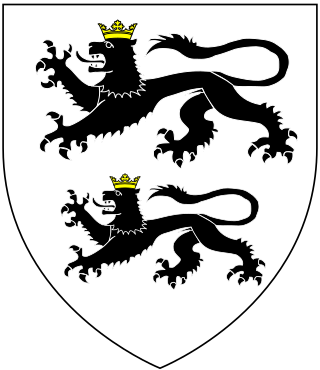
William Catesby was one of Richard III of England's principal councillors. He also served as Chancellor of the Exchequer and Speaker of the House of Commons during Richard's reign. The Catesbys’ medieval wealth derived from livestock and the zenith of their political achievement came during his career.
Sir Robert Brackenbury was an English courtier, who was Constable of the Tower of London during the reign of Richard III. He is believed to have been responsible for enabling the (presumed) murders of the Princes in the Tower, though there is no conclusive evidence to prove it. He died defending the King at the Battle of Bosworth Field in 1485.

Richard III is a 1955 British Technicolor film adaptation of William Shakespeare's historical play of the same name, also incorporating elements from his Henry VI, Part 3. It was directed and produced by Laurence Olivier, who also played the lead role. Featuring many noted Shakespearean actors, including a quartet of actors who were later knighted, the film depicts Richard plotting and conspiring to grasp the throne from his brother King Edward IV, played by Sir Cedric Hardwicke. In the process, many are killed and betrayed, with Richard's evil leading to his own downfall. The prologue of the film states that history without its legends would be "a dry matter indeed", implicitly admitting to the artistic licence that Shakespeare applied to the events of the time.
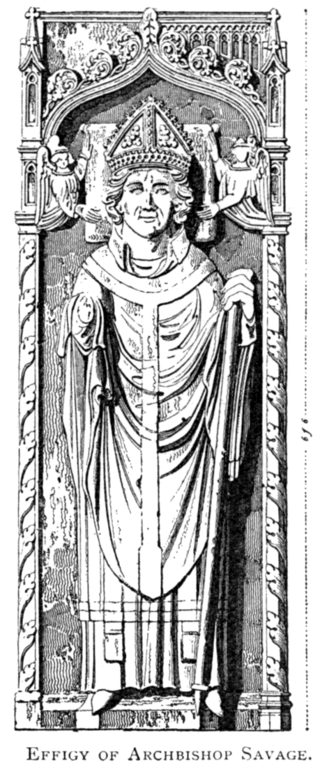
Thomas Savage was a prelate, diplomat and scholar during the Tudor period. Savage served as Chaplain to King Henry VII and was Archbishop of York from 1501 until his death in 1507. Prior to his consecration as a Bishop, Savage served as a diplomat and rector. As a diplomat Savage held the positions of English Ambassador to Castile and Portugal, during which time he helped broker the marriage treaty between Arthur, Prince of Wales and Catherine of Aragon in 1489, and later held the position of English Ambassador to France from 1490, where he took part in the conference at Boulogne.
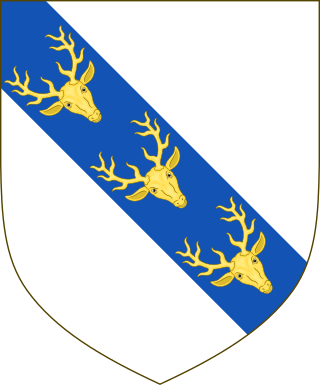
Sir Thomas Stanley, 1st Baron Stanley, titular King of Mann, KG, of Lathom and Knowsley, Lancashire, was a Privy Councillor, Comptroller of the Royal Household, Lieutenant-Governor of Ireland (1431–36), Chief Steward of the Duchy of Lancaster, Knight of the Shire for Lancashire, Constable & Justice of Chester, Chamberlain of North Wales, Lord Chamberlain (1455), and from 15 January 1456 was summoned by Writ to Parliament as Lord Stanley.

Thomas Stanley, 2nd Earl of Derby was an English nobleman, politician, and peer.

The Stafford and Lovell rebellion was the first armed uprising against King Henry VII after he won the crown at the Battle of Bosworth in 1485. The uprising was led by Francis Lovell, Viscount Lovell, along with Sir Humphrey Stafford and Thomas Stafford, brothers from Grafton, Worcestershire. The uprising occurred during Eastertime 1486.
The Standard Bearer of England was once an important office within the English army, especially during the times when Kings were still present on the battlefield. As standard-bearer Henry de Essex was greatly chastised when he threw down the English Standard and claimed his King (Stephen) was dead in 1153.
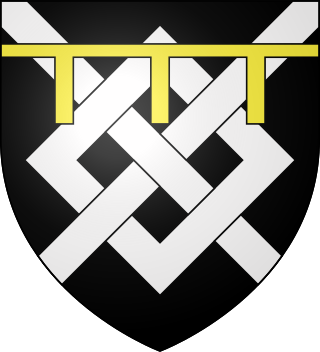
Sir James Harrington of Hornby was an English politician and soldier who was a prominent Yorkist supporter in Northern England during the Wars of the Roses, having been retained by Richard Neville, 5th Earl of Salisbury, who was brother-in-law to the head of the House of York, Richard of York. He was the second son of Sir Thomas Harrington, who had died with the king's father at the Battle of Wakefield in December 1460. James himself had fought with Salisbury at the Battle of Blore Heath in 1459, where he had been captured and imprisoned by the Lancastrians until the next year. He was a significant regional figure during the reign of King Edward IV, although the early years of the new king's reign were marred by a bitter feud between him and the Stanley family over a castle in Lancashire. On the accession of King Richard III in 1483, he was appointed to the new king's Household, and as such was almost certainly with him at the Battle of Bosworth Field two years later. It is likely that he fell in battle there, although precise details of his death are now unknown.

Sir Percival Thirlwall was the standard-bearer of Richard III during the Battle of Bosworth Field, the penultimate battle in the Wars of the Roses which ultimately brought an end to the reign of the Plantagenets and inaugurated the Tudor dynasty.

Sir John Savage, KG, KB, PC (1444–1492), was an English knight of the Savage family, who was a noted military commander of the late 15th-century. Savage most notably fought at the Battle of Bosworth Field in 1485, where he commanded the left flank of the Tudor (Lancastrian) army to victory and is said to have personally slain the Duke of Norfolk in single combat. Earlier in the Wars of the Roses, Savage had been a supporter and friend of the Yorkist King Edward IV, fighting alongside him and helping him to victories at the Battle of Barnet in 1471 and the Battle of Tewkesbury later that same year, as well as joining the Duke of Gloucester's invasion of Scotland in 1482, where the Duke made him a Knight banneret. However, following the death of Edward and the Duke of Gloucester's ascension to the throne as Richard III the Savage family was viewed with suspicion due to their familial connection to the Stanleys, who were in turn connected to the Tudors. Consequently Savage was one of the prominent figures who invited Henry Tudor to invade England in 1485, a struggle which culminated in the Battle of Bosworth Field. After his victory Henry Tudor received the circlet of Richard from Savage's uncle Lord Stanley and was crowned King of England on the field of battle, taking the throne as Henry VII of England.
Sir John Babington of Dethick Manor was High Sheriff of Nottinghamshire, Derbyshire and the Royal Forests from 1479-1480.

The Savage family is an English noble family founded by Thomas Le Sauvage (Savage), who came to England as part of William the Conqueror's Norman army in 1066 and settled in Derbyshire after the conquest, taking residence in Scarcliffe. Thomas Le Sauvage's name appears in a list of Normans who survived the Battle of Hastings. In the 14th century a branch of the family was established in Cheshire, and this was the place where they became most prominent, with several members ascending to the peerage and positions of power such as Archbishop of York. The Cheshire branch of the family built the primary family seat Rocksavage, the house was one of the great Elizabethan houses of the county and a leading example of the Elizabethan prodigy house. There were further branches of the family in Dorset, Gloucestershire and Kent, as well as one in Ireland, which was created following the arrival of Sir William Savage, Baron Savage in Ulster as a companion of Sir John de Courcy. Many of the family are buried in tombs in the family chapel at St Michael's Church, Macclesfield.
References
- ↑ The Ballad Index Copyright 2015 by Robert B. Waltz and David G. Engle. Accessed March 2015
- ↑ Encyclopedia of the Wars of the Roses by John A. Wagner (ABC-Clio Inc, 2001).
- ↑ "A Nation in Conflict: the Battle of Bosworth Field", Warfare, 22 August 2013. Accessed March 2015
- ↑ The Ballad of Bosworth Fielde, Text from Bishop Percy’s Folio Manuscript. Ballads and Romances, ed. J.W. Hales and F.J. Furnivall, 3 vols. (London, 1868), III, pp. 233-59. Reproduced by kind permission of Department of Special Collections, University of Pennsylvania Library